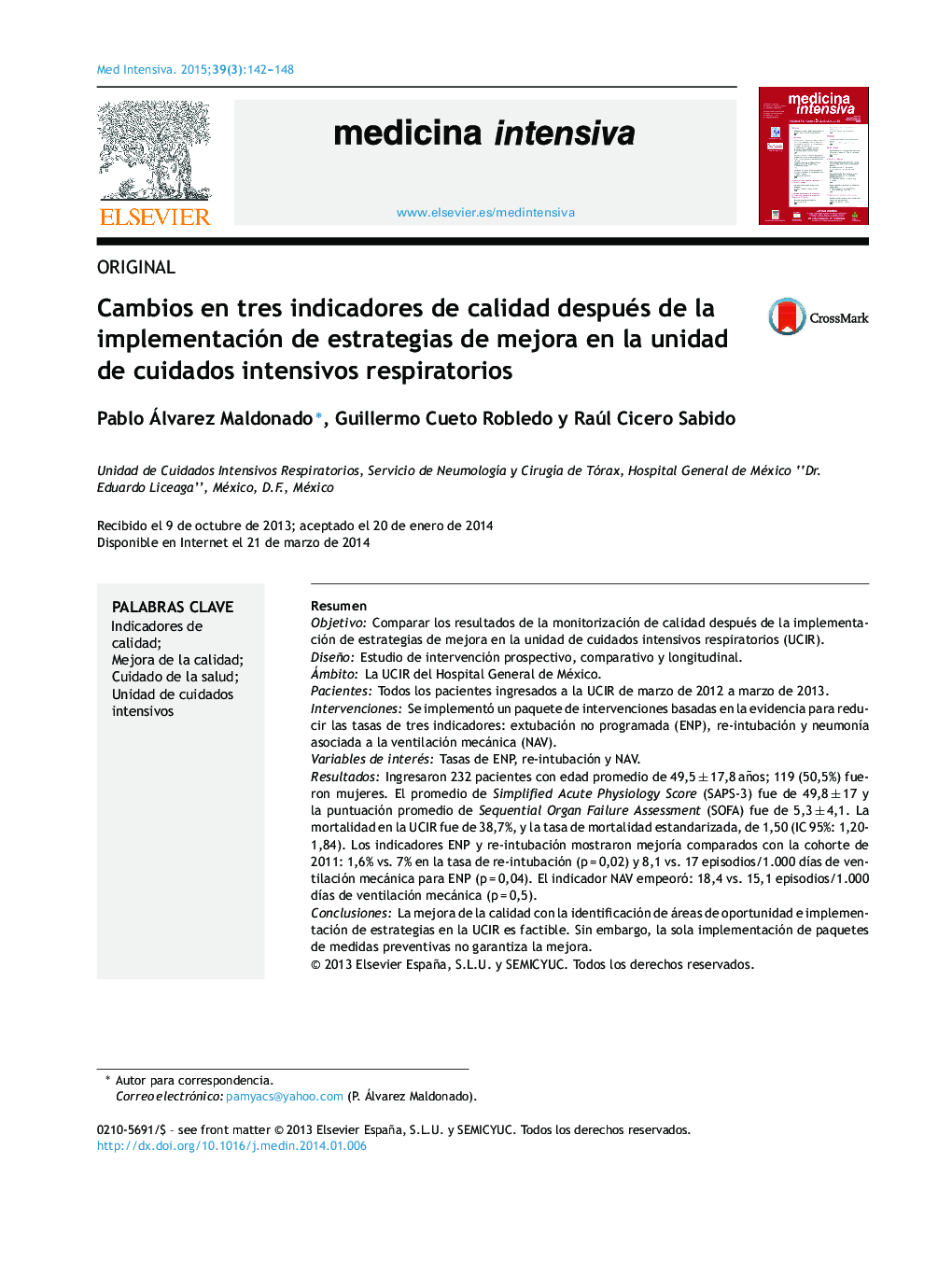| Article ID | Journal | Published Year | Pages | File Type |
|---|---|---|---|---|
| 3112646 | Medicina Intensiva | 2015 | 7 Pages |
ResumenObjetivoComparar los resultados de la monitorización de calidad después de la implementación de estrategias de mejora en la unidad de cuidados intensivos respiratorios (UCIR).DiseñoEstudio de intervención prospectivo, comparativo y longitudinal.ÁmbitoLa UCIR del Hospital General de México.PacientesTodos los pacientes ingresados a la UCIR de marzo de 2012 a marzo de 2013.IntervencionesSe implementó un paquete de intervenciones basadas en la evidencia para reducir las tasas de tres indicadores: extubación no programada (ENP), re-intubación y neumonía asociada a la ventilación mecánica (NAV).Variables de interésTasas de ENP, re-intubación y NAV.ResultadosIngresaron 232 pacientes con edad promedio de 49,5 ± 17,8 años; 119 (50,5%) fueron mujeres. El promedio de Simplified Acute Physiology Score (SAPS-3) fue de 49,8 ± 17 y la puntuación promedio de Sequential Organ Failure Assessment (SOFA) fue de 5,3 ± 4,1. La mortalidad en la UCIR fue de 38,7%, y la tasa de mortalidad estandarizada, de 1,50 (IC 95%: 1,20-1,84). Los indicadores ENP y re-intubación mostraron mejoría comparados con la cohorte de 2011: 1,6% vs. 7% en la tasa de re-intubación (p = 0,02) y 8,1 vs. 17 episodios/1.000 días de ventilación mecánica para ENP (p = 0,04). El indicador NAV empeoró: 18,4 vs. 15,1 episodios/1.000 días de ventilación mecánica (p = 0,5).ConclusionesLa mejora de la calidad con la identificación de áreas de oportunidad e implementación de estrategias en la UCIR es factible. Sin embargo, la sola implementación de paquetes de medidas preventivas no garantiza la mejora.
ObjectiveTo compare the results of quality monitoring after the implementation of improvement strategies in the respiratory intensive care unit (RICU).DesignA prospective, comparative, longitudinal and interventional study was carried out.SettingThe RICU of Hospital General de México (Mexico).PatientsAll patients admitted to the RICU from March 2012 to March 2013.InterventionsAn evidence-based bundle of interventions was implemented in order to reduce the ratios of three quality indicators: non-planned extubation (NPE), reintubation, and ventilator-associated pneumonia (VAP).Variables of interestNPE, reintubation and VAP ratios.ResultsA total of 232 patients were admitted, with a mean age of 49.5 ± 17.8 years; 119 (50.5%) were woman. The mean Simplified Acute Physiology Score (SAPS-3) was 49.8 ± 17, and the mean Sequential Organ Failure Assessment (SOFA) score was 5.3 ± 4.1. The mortality rate in the RICU was 38.7%. The standardized mortality ratio was 1.50 (95% CI: 1.20-1.84). An improved ratio was observed for reintubation and NPE indicators compared to the ratios of the previous 2011 cohort: 1.6% vs. 7% (P = .02) and 8.1 vs. 17 episodes per 1000 days of mechanical ventilation (P = .04), respectively. A worsened VAP ratio was observed: 18.4 vs. 15.1 episodes per 1000 days of mechanical ventilation (P = .5).ConclusionsQuality improvement is feasible with the identification of areas of opportunity and the implementation of strategies. Nevertheless, the implementation of a bundle of preventive measures in itself does not guarantee improvements.
